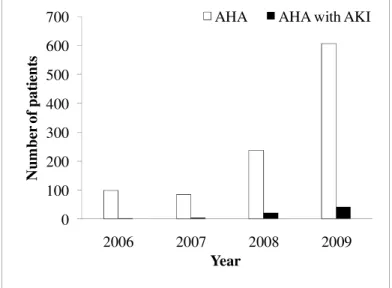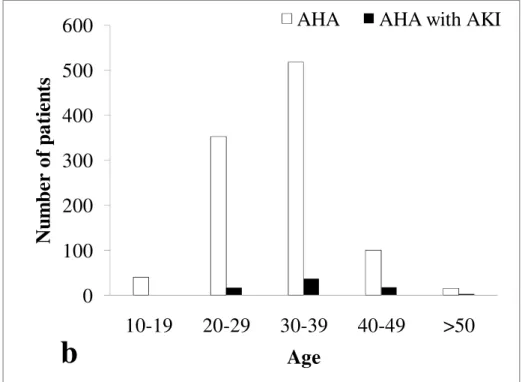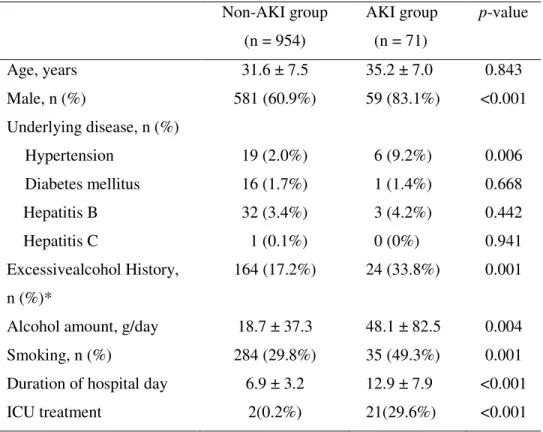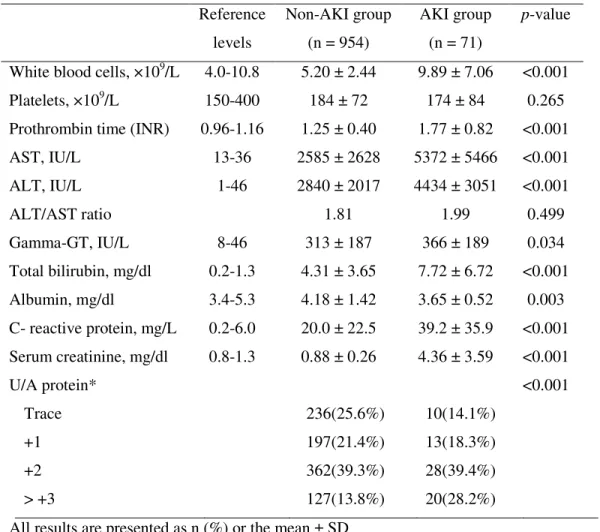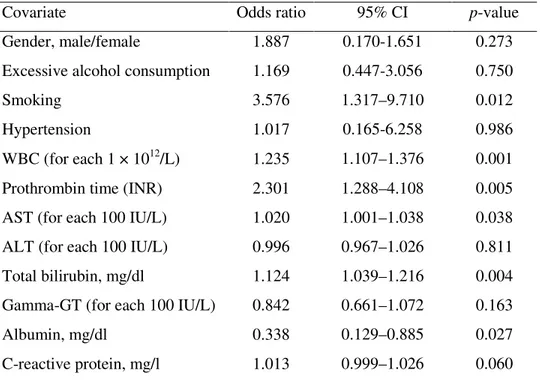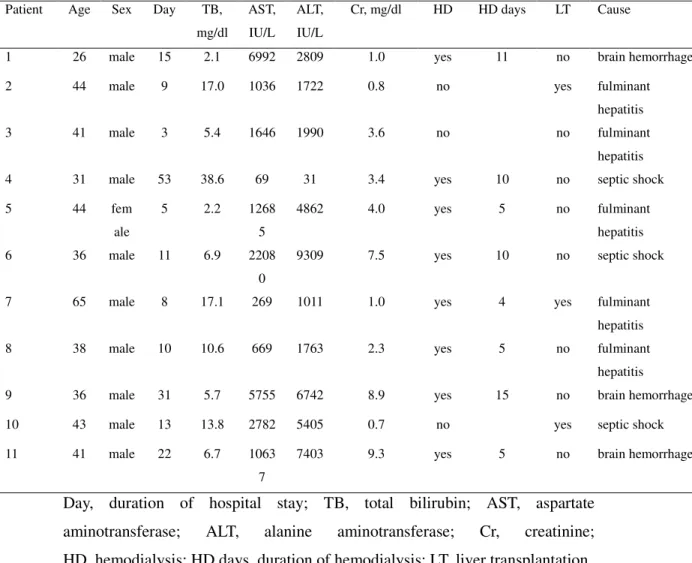I
Recent changes and clinical
characteristics of acute hepatitis A
complicated by acute kidney injury
Jung Hwan Yu
Department of Medicine
II
Recent changes and clinical
characteristics of acute hepatitis A
complicated by acute kidney injury
Directed by Professor Kwan Sik Lee
The Master's Thesis submitted to the Department of
Medicine, the Graduate School of Yonsei University
in partial fulfillment of the requirements for the degree
of Master of Medical Science
Jung Hwan Yu
III
This certifies that the Master's Thesis of
Jung Hwan Yu is approved.
---
Thesis Supervisor : Kwan Sik Lee
---
[Hyeong Cheon Park: Thesis Committee Member#1)
---
[Soon Won Hong: Thesis Committee Member#2)
The Graduate School
Yonsei University
IV
ACKNOWLEDGEMENTS
먼저 석사 과정 동안 아낌없는 관심과 격려를 해주신 이관식 교수님께 진심으로 감사 드립니다. 항상 서툴고 부족한 저에게 석사 과정을 무사히 마칠 수 있도록 도와주신 박형천 교수님과 홍순원 교수님께도 다시 한번 감사의 마음을 전합니다. 처음 강남 세브란스에 내과 전공의로 일을 시작한게 엊그제 같은데 벌써 병원을 떠나야 하는 시기가 가까워 왔습니다. 강남 세브란스 병원에서의 5년간의 시간은 어렵고 힘들었지만, 나에게 고난의 시간만은 아니었습니다. 많은 교수님의 정성 어린 지도로 어느덧 내과 의사로서의 자질을 조금씩 갖추어 가게 되었고, 그런 와중에 시작한 석사 과정은 내가 한층 더 발전할 수 있는 계기가 되지 않았나 싶습니다. 석사 과정을 처음 시작할 때는 다른 사람들도 하니까 나도 할 수 있겠지 남들이 할 때는 한없이 쉽게만 느껴졌었습니다. 하지만 처음 해보는 데이터 정리와 통계, 영어 시험과 종합시험은 나에게 많은 고민과 스트레스를 안겨 주기도 하고, 일이 잘 진행되지 않을 때면 내가 이걸 왜 시작해서 고생이지라는 생각도 하곤 했습니다. 하지만 돌이켜 생각해 보니 이러한 과정이 좀더 나를 조금씩 달련 시키는 과정이 아니었나 싶고, 지금으로서는 그러한 과정을 거쳤다는 것이 스스로 자랑스럽고, 정말 최선의 선택이었다고 생각이 듭니다. 2년전 처음 연구 주제를 받았을 때가 기억이 납니다. 지금의 연구 주제로 생전 처음 학회란 곳에 참석해 포스터 전시도 하고 포스터 구연도 했던 그 떨림과 설레임을 지금도 잊을 수가 없습니다. 연구나 포스터에 무지했었던 나에게 이 모든 것이 가능하게 했던 건, 통계부터 포스터 제작에 이르기까지 하나 하나 지도해 주셨던 소화기내과 여러 교수님들 도움이 있었기 때문입니다. 특히 김자경 교수님께 감사의 말씀을 전합니다. 또한 석사 과정 및 전공의 수련 과정에서 나에게 많은 위로가 되고 힘이 되어 준 내과 4년차 동기들과 내과 의국원들에게도 감사의V 말을 전하고 싶습니다. 전문의가 되어 병원을 떠나더라도 언제든 연락하고 지냈으면 좋겠습니다. 마지막으로 그동안 저를 믿어주고 항상 도와주시는 부모님과 여동생 그리고 제가 사랑하는 아내에게 감사의 마음을 전합니다. 2010년 10월 19일 유정환
VI
<TABLE OF CONTENTS>
ABSTRACT ··· 1
I. INTRODUCTION ··· 3
II. MATERIALS AND METHODS ··· 5
1. Patent selection ··· 5 2. Statistical analysis ··· 5 III. RESULTS ··· 6 IV. DISCUSSION ··· 15 V. CONCLUSION ··· 18 REFERENCES ··· 19 ABSTRACT(IN KOREAN) ··· 22
VII
LIST OF FIGURES
Figure 1a. Number of patients with AHA and AKI in each
year studied
.
··· 6
Figure 1b. Distribution of AHA and AKI
according to patient
VIII
LIST OF TABLES
Table 1. Baseline characteristics of the patients with AHA ·· 9
Table 2. Laboratory findings of the patients at presentation·· 10
Table 3. The independent risk factors for the development of
AKI in AHA.
12
Table 4. Risk, Injury, Failure, Loss, and End-stage kidney
disease (RIFLE) classification of hepatitis A patients with
acute renal failure ··· 13
Table 5. Clinical and laboratory data for the 11 patients who
1 ABSTRACT
Recent changes and clinical characteristics of acute hepatitis A complicated by acute kidney injury
Jung Hwan Yu
Department of Medicine
The Graduate School, Yonsei University (Directed by Professor Kwan Sik Lee)
The incidence of acute viral hepatitis A (AHA) in Korea is increasing quickly. In addition, we are encountering more cases with acute kidney injury (AKI), which was once regarded as a rare complication of AHA. Therefore, we investigated recent aspects of the incidence and clinical characteristics of AHA complicated by AKI. Patients diagnosed with acute hepatitis A at Severance Hospital and Gangnam Severance Hospital from January 2006 to December 2009 were enrolled. Of 1025 patients, 71 (6.9%) had AKI. The incidence of AKI was 3.1%, 6.0%, 8.9%, and 6.9% in 2006 to 2009, respectively. Patients with AKI were predominantly male, heavy alcohol drinkers and smokers and had more underlying hypertension than patients without AKI. The patients with AKI had significantly higher white blood cell counts, more prolonged prothrombin times, and elevated liver enzymes, total bilirubin, direct bilirubin, gamma-glutamyltransferase, C-reactive protein, and higher peak of total bilirubin levels, whereas the serum albumin level was lower compared to patients without AKI. Most patients with AHA complicated by AKI recover with conservative treatment, however, we should
2
pay attention to the patients who have risk factors for AKI because of their possible poor clinical course.
--- Key words : acute kidney injury, acute hepatitis A
3
Recent changes and clinical characteristics of acute hepatitis A complicated by acute kidney injury
Jung Hwan Yu
Department of Medicine
The Graduate School, Yonsei University (Directed by Professor Kwan Sik Lee)
I. INTRODUCTION
Acute hepatitis A (AHA) occurs worldwide and is an important public health problem. Recently, its incidence has gradually decreased due to hepatitis A vaccinations and improved public hygiene1, 2. Conversely, in Korea, the number of AHA patients has increased gradually and the number of cases accompanied by acute kidney injury (AKI), a rare complication of hepatitis A, has also increased3-6. After it’s first report by Wilkinson et al. in 19787, AHA accompanied by AKI has been reported regularly, and the frequency reaches 3~7.2%4, 8. If AHA is accompanied by AKI, the patient often experiences more severe disease with longer hospital stay and recovery is slower. Therefore, more attention should be paid to such cases. In this study, AHA patients were divided
4
into those with and without accompanying AKI to examine differences in their clinical characteristics.
5
II. MATERIALS AND METHODS
1. Patient selection
Patients diagnosed with AHA at Severance Hospital and Gangnam Severance Hospital from January 2006 to December 2009 were enrolled. The diagnosis was based on the clinical symptoms and signs and confirmed by the presence of anti-HAV-IgM antibodies. Demographic and serologic data, urinalysis, history including alcohol consumption, and days in hospital were analyzed retrospectively. Exclusion criteria were chronic renal failure, liver cirrhosis, and other renal disease. AKI was defined as an increase in the serum creatinine concentration of >0.5 mg/dl or 50% compared with the baseline value9. In AKI group, hepatorenal syndrome was ruled out through urine test (Hepatorenal syndrome shows urine red cell excretion of less than 50 cells per high power field and protein excretion less than 500mg/day). The definition of a heavy alcoholic was an alcohol consumption >45 g/day. Smoking was defined as current smokers who smoke at least 10 cigarettes a day.
2. Statistical analysis
To compare numerical variables, the Student’s t-test was applied, and for categorical variables, the chi-square test was used. To identify the risk factors for AKI in AHA, we used multivariate logistic regression analyses. All data
6
were analyzed using SPSS version 16.0 (SPSS, Chicago, IL, USA). The level of statistical significance was p < 0.05.
III. RESULTS
The number of AHA patients increased markedly in 2009 compared to 2006 to 2008 at both Severance Hospital and Gangnam Severance Hospital. Of the 1025 patients, 71 (6.9%) had accompanying AKI. The proportion tended to increase over the 4 years, and was 3.1% (3/98), 6.0% (5/84), 8.9% (21/237), and 6.9% (42/606) in 2006 to 2009, respectively (Figure 1a).
Figure 1. a) Number of patients with AHA and AKI in each year studied.
0 100 200 300 400 500 600 700 2006 2007 2008 2009 N u m b er o f p a ti en ts Year
AHA AHA with AKI
7
When the distribution of AHA was reviewed by age range, AHA was most frequent in patients in their 20s and 30s. The number of cases accompanied by AKI was greatest in patients in their 30s (n=36) followed by those in their 40s (n=17) (Figure 1b).
Figure 1. b) Distribution of AHA and AKI according to patient age.
0
100
200
300
400
500
600
10-19
20-29
30-39
40-49
>50
N
u
m
b
er
o
f
p
a
ti
en
ts
Age
AHA
AHA with AKI
8
The average age of the AHA patients in the group with accompanying AKI was 35.2 years, and it was not significantly different compared with that for the group without AKI, which was 31.6 years. The proportion of males was greater in the group with AKI. Regarding underlying diseases, the group with AKI had a statistically greater proportion of patients with hypertension, and significantly more patients who reported high alcohol intake and who were smokers. The average hospitalization was 6.9 days in the group without AKI versus 12.9 days with AKI, and this difference was significant (P<0.001) (Table 1).
Regarding the laboratory findings, the leukocyte count, prothrombin time (INR), and aspartate aminotransferase (AST), alanine aminotransferase (ALT), C-reactive protein, total bilirubin, peak total bilirubin, and gamma-glutamyltransferase levels were significantly higher in the group with AKI, as was the urine protein level (Table 2).
Regarding the laboratory findings, the leukocyte count, prothrombin time (INR), and aspartate aminotransferase (AST), alanine aminotransferase (ALT), C-reactive protein, total bilirubin, peak total bilirubin, and gamma-glutamyltransferase levels were significantly higher in the group with AKI, as was the urine protein level (Table 2).
9
Table 1. Baseline characteristics of the patients with AHA
Non-AKI group (n = 954) AKI group (n = 71) p-value Age, years 31.6 ± 7.5 35.2 ± 7.0 0.843 Male, n (%) 581 (60.9%) 59 (83.1%) <0.001 Underlying disease, n (%) Hypertension 19 (2.0%) 6 (9.2%) 0.006 Diabetes mellitus 16 (1.7%) 1 (1.4%) 0.668 Hepatitis B 32 (3.4%) 3 (4.2%) 0.442 Hepatitis C 1 (0.1%) 0 (0%) 0.941 Excessivealcohol History, n (%)* 164 (17.2%) 24 (33.8%) 0.001 Alcohol amount, g/day 18.7 ± 37.3 48.1 ± 82.5 0.004 Smoking, n (%) 284 (29.8%) 35 (49.3%) 0.001 Duration of hospital day 6.9 ± 3.2 12.9 ± 7.9 <0.001 ICU treatment 2(0.2%) 21(29.6%) <0.001 All results are presented as n (%) or the mean ± SD
* Excessive alcohol consumption is defined as alcohol consumption >45 g/day. AKI, acute kidney injury; ICU, Intensive Care Unit
10
Table 2. Laboratory findings of the patients at presentation
All results are presented as n (%) or the mean ± SD *Dipstick urinalysis
Gamma-GT, gamma-glutamyltransferase; INR, international normalization ratio; AST, aspartate aminotransferase; ALT, alanine aminotransferase
Reference levels Non-AKI group (n = 954) AKI group (n = 71) p-value White blood cells, ×109/L 4.0-10.8 5.20 ± 2.44 9.89 ± 7.06 <0.001 Platelets, ×109/L 150-400 184 ± 72 174 ± 84 0.265 Prothrombin time (INR) 0.96-1.16 1.25 ± 0.40 1.77 ± 0.82 <0.001 AST, IU/L 13-36 2585 ± 2628 5372 ± 5466 <0.001 ALT, IU/L 1-46 2840 ± 2017 4434 ± 3051 <0.001 ALT/AST ratio 1.81 1.99 0.499 Gamma-GT, IU/L 8-46 313 ± 187 366 ± 189 0.034 Total bilirubin, mg/dl 0.2-1.3 4.31 ± 3.65 7.72 ± 6.72 <0.001 Albumin, mg/dl 3.4-5.3 4.18 ± 1.42 3.65 ± 0.52 0.003 C- reactive protein, mg/L 0.2-6.0 20.0 ± 22.5 39.2 ± 35.9 <0.001 Serum creatinine, mg/dl 0.8-1.3 0.88 ± 0.26 4.36 ± 3.59 <0.001 U/A protein* <0.001 Trace 236(25.6%) 10(14.1%) +1 197(21.4%) 13(18.3%) +2 362(39.3%) 28(39.4%) >.+3 127(13.8%) 20(28.2%)
11
To identify the risk factors for AKI in AHA, we used multivariate logistic regression analysis. Multivariate analysis revealed that smoking, higher WBC count, ALT, and total bilirubin, prolonged prothrombin time, and lower albumin level were independent predictors of AKI (Table 3).
We assessed the severity of AKI with the Risk, Injury, Failure, Loss, and End-stage kidney disease (RIFLE) classification in the 60 patients who survived. The patient distribution according to RIFLE classification were 9, 16, 26, 8, and 1 patient, respectively. The patient with failure, defined as a serum creatinine × 3 or serum creatinine ≥4 mg/dl with an acute rise >0.5 mg/dl were most frequent, but most of them recovered to normal renal function within 1 month. Nine patients had prolonged renal dysfunction for up to 1 month. Only one patient had continued for more than 3 months (Table 4).
In our series, 11 of 1025 patients (1.1%) died due to complications of AHA. Most of them were male, and they had high total bilirubin and creatinine levels on admission. Eight patients underwent hemodialysis, and three had liver transplants (Table 5).
12
Table 3. The independent risk factors for the development of AKI in
AHA.
Covariate Odds ratio 95% CI p-value Gender, male/female 1.887 0.170-1.651 0.273 Excessive alcohol consumption 1.169 0.447-3.056 0.750 Smoking 3.576 1.317–9.710 0.012 Hypertension 1.017 0.165-6.258 0.986 WBC (for each 1 × 1012/L) 1.235 1.107–1.376 0.001 Prothrombin time (INR) 2.301 1.288–4.108 0.005 AST (for each 100 IU/L) 1.020 1.001–1.038 0.038 ALT (for each 100 IU/L) 0.996 0.967–1.026 0.811 Total bilirubin, mg/dl 1.124 1.039–1.216 0.004 Gamma-GT (for each 100 IU/L) 0.842 0.661–1.072 0.163 Albumin, mg/dl 0.338 0.129–0.885 0.027 C-reactive protein, mg/l 1.013 0.999–1.026 0.060 WBC, White blood count; Gamma-GT, gamma-glutamyltransferase; INR, international normalization ratio; AST, aspartate aminotransferase; ALT, alanine aminotransferase; AKI, acute kidney injury
13
Table 4. Risk, Injury, Failure, Loss, and End-stage kidney disease
(RIFLE) classification of hepatitis A patients with acute renal failure
RIFLE class Glomerular filtration rate criteria Patient numbers (%) Risk Serum creatinine × 1.5 9 (15%) Injury Serum creatinine × 2 16 (26.6%) Failure Serum creatinine × 3 or serum
creatinine ≥4 mg/dl with an acute rise >0.5 mg/dl
26 (43.3%)
Loss Persistent acute renal failure = complete loss of kidney function
>4 weeks
8 (13.3%)
End-stage kidney disease
End-stage kidney disease >3 months
14
Table 5. Clinical and laboratory data for the 11 patients who died from
complications of AHA.
Day, duration of hospital stay; TB, total bilirubin; AST, aspartate aminotransferase; ALT, alanine aminotransferase; Cr, creatinine; HD, hemodialysis; HD days, duration of hemodialysis; LT, liver transplantation
Patient Age Sex Day TB,
mg/dl AST, IU/L ALT, IU/L Cr, mg/dl HD HD days LT Cause
1 26 male 15 2.1 6992 2809 1.0 yes 11 no brain hemorrhage
2 44 male 9 17.0 1036 1722 0.8 no yes fulminant
hepatitis
3 41 male 3 5.4 1646 1990 3.6 no no fulminant
hepatitis
4 31 male 53 38.6 69 31 3.4 yes 10 no septic shock
5 44 fem ale 5 2.2 1268 5 4862 4.0 yes 5 no fulminant hepatitis 6 36 male 11 6.9 2208 0
9309 7.5 yes 10 no septic shock
7 65 male 8 17.1 269 1011 1.0 yes 4 yes fulminant
hepatitis
8 38 male 10 10.6 669 1763 2.3 yes 5 no fulminant
hepatitis
9 36 male 31 5.7 5755 6742 8.9 yes 15 no brain hemorrhage
10 43 male 13 13.8 2782 5405 0.7 no yes septic shock
11 41 male 22 6.7 1063
7
15
IV. DISCUSSION
Until recently, AHA accompanied by AKI was considered rare. In our series, however, the incidence was relatively high at 6.9%. AHA responds to conservative treatment in most cases, even when accompanied by AKI. Consequently, AKI might easily be overlooked in AHA unless the appropriate blood tests are performed. In our series, most (85%, 60/71) of the patients with accompanying AKI had high initial creatinine levels, so we feel that blood creatinine level should be determined for patients admitted to the hospital with AHA-related symptoms or confirmed AHA. In Korea, the frequency of AHA accompanied by AKI has recently increased gradually, as was also seen in our series. Therefore, this should be monitored in future studies.
Regarding the cause of AKI in AHA, several hypotheses have been proposed. First, dehydration due to pre-renal factors, such as vomiting and diarrhea, may cause circulatory collapse, which activates the rennin–angiotensin system and reduces renal blood flow10, 11. In our series, 67.9% (38/56) of the patients with accompanying AKI had a pre-renal fractional excretion of sodium (FENa) <1, implying that dehydration resulting from anorexia, vomiting, and diarrhea caused by AHA was a major cause of the AKI in most of these patients. Another cause is hyperbilirubinemia, which reduces peripheral blood vessels, thereby reducing the effective blood volume and inducing renal blood and structures to react sensitively to substances inducing vascular contraction12. The high total
16
bilirubin levels in the group with AKI in our series support this possibility. In addition, there are reports of AKI caused by immune complexes13 or endotoxins14, although the mechanisms are unclear. As it is difficult to examine the histology of AHA patients with AKI so as to investigate the cause of the pathologically, some reports have implicated acute tubular necrosis15, 16, mesangium endothelialization, or immune complex deposition17. Many future studies of the cause of AKI in AHA are necessary.
Although the majority of our patients with accompanying AKI improved with conservative treatment, 25 patients needed hemodialysis. In 17 of the hemodialysis patients, renal functions recovered gradually after the hemodialysis, whereas in the remaining eight patients, the disease gradually progressed to fulminant hepatitis after hemodialysis. Ultimately, these eight patients died from complications of AHA. The patients requiring hemodialysis were typically male and heavy alcoholics. However, the number was small, so larger patient groups should be studied in the future.
Most of the AHA patients had positive urine protein tests, especially those with accompanying AKI. This reflects the excretion of large amounts of protein in the urine in AHA patients. As this is not a quantitative measure of urine proteins, but the result of testing for albumin values, this phenomenon should be studied further.
17
mellitus have been reported to be related risk factors3, 18-21. In our series, smoking, elevated leukocyte count, higher AST and total bilirubin values, prolonged prothrombin time (INR), and lower albumin level were significant independent risk factors.
18
V. CONCLUSION
In summary, most of AHA complicated with AKI could recover by
conservative treatment, however, if they are smokers, elevated leukocyte
count, higher AST and total bilirubin values, prolonged prothrombin time
(INR), and lower albumin, there would be higher possibility of AKI
complication. Attentive observation is required for the patients carrying
19
REFERENCES
1. Jacobsen KH, Koopman JS. Declining hepatitis A seroprevalence: a global review and analysis. Epidemiol Infect 2004 Dec;132(6):1005-22.
2. Sharapov MB, Favorov MO, Yashina TL, Brown MS, Onischenko GG, Margolis HS, et al. Acute viral hepatitis morbidity and mortality associated with hepatitis E virus infection: Uzbekistan surveillance data. BMC Infect Dis 2009;9:35.
3. Kim SH, Yoon HE, Kim YK, Kim JY, Choi BS, Choi YJ, et al. Acute hepatitis A-associated acute renal failure in adults. Nephron Clin Pract 2008;109(3):c127-32.
4. Jung YJ, Kim W, Jeong JB, Kim BG, Lee KL, Oh KH, et al. Clinical features of acute renal failure associated with hepatitis A virus infection. J Viral Hepat 2009 Oct 11.
5. Fan PC, Chen YC, Tian YC, Chang CH, Fang JT, Yang CW. Acute renal failure associated with acute non-fulminant hepatitis A: a case report and review of literature. Ren Fail 2009;31(8):756-64.
6. Sarawgi S, Gupta AK, Arora DS, Jasuja S. Acute renal failure associated with nonfulminant acute viral hepatitis A. Indian J Nephrol 2008 Apr;18(2):77-9. 7. Wilkinson DG, Boyd DH. Recovery from acute interstitial nephritis. Br Med J 1978 Apr 1;1(6116):827-8.
20
acute hepatitis A. Scand J Infect Dis 2009;41(11-12):869-72.
9. Thadhani R, Pascual M, Bonventre JV. Acute renal failure. N Engl J Med 1996 May 30;334(22):1448-60.
10. Nachbaur K, Konig P, Rumpelt HJ, Schobel B, Lhotta K, Vogel W. Acute renal failure complicating non-fulminant hepatitis A. Clin Nephrol 1996 Jun;45(6):398-400.
11. Adas M, Tanakol R, Yarman S, Boztepe H, Ecder T, Alagol F. Acute renal failure associated with nonfulminant hepatitis A virus infection. Ren Fail 2002 Jan;24(1):97-102.
12. Green J, Beyar R, Bomzon L, Finberg JP, Better OS. Jaundice, the circulation and the kidney. Nephron 1984;37(3):145-52.
13. Morita M, Kitajima K, Yoshizawa H, Itoh Y, Iwakiri S, Shibata C, et al. Glomerulonephritis associated with arteritis in marmosets infected with hepatitis A virus. Br J Exp Pathol 1981 Feb;62(1):103-13.
14. Green J, Better OS. Systemic hypotension and renal failure in obstructive jaundice-mechanistic and therapeutic aspects. J Am Soc Nephrol 1995 May;5(11):1853-71.
15. Song KS, Kim MJ, Jang CS, Jung HS, Lee HH, Kwon OS, et al. [Clinical features of acute viral hepatitis A complicated with acute renal failure]. Korean J Hepatol 2007 Jun;13(2):166-73.
16. Faust RL, Pimstone N. Acute renal failure associated with nonfulminant hepatitis A viral infection. Am J Gastroenterol 1996 Feb;91(2):369-72.
21
17. McCann UG, 2nd, Rabito F, Shah M, Nolan CR, 3rd, Lee M. Acute renal failure complicating nonfulminant hepatitis A. West J Med 1996
Nov;165(5):308-10.
18. Nash K, Hafeez A, Hou S. Hospital-acquired renal insufficiency. Am J Kidney Dis 2002 May;39(5):930-6.
19. Leblanc M, Kellum JA, Gibney RT, Lieberthal W, Tumlin J, Mehta R. Risk factors for acute renal failure: inherent and modifiable risks. Curr Opin Crit Care 2005 Dec;11(6):533-6.
20. Parfrey PS, Griffiths SM, Barrett BJ, Paul MD, Genge M, Withers J, et al. Contrast material-induced renal failure in patients with diabetes mellitus, renal insufficiency, or both. A prospective controlled study. N Engl J Med 1989 Jan 19;320(3):143-9.
21. Schmekal B, Pichler R, Biesenbach G. Causes and prognosis of
nontraumatic acute renal failure requiring dialysis in adult patients with and without diabetes. Ren Fail 2004 Jan;26(1):39-43.
22 ABSTRACT (IN KOREAN)
급성 신부전과 동반된 급성 A형 간염의 최근 변화와 임상상 <지도교수 이관식 > 연세대학교 대학원 의학과 유정환 배경/목적 : 급성 A형 간염은 최근 국내에서 급격한 증가 양상을 보이고 있으며, 이에 따라 그동안 급성 A형 간염의 드문 합병증으로 알려져 왔던 급성신부전을 동반한 환자도 점차 증가하고 있다. 본 연구에서는 급성신부전을 동반한 급성 A형 간염 환자의 빈도 증가 추이를 알아보고, 이들의 임상적 특징을 알아보고자 하였다. 대상 및 방법 : 2006년 1월부터 2009년 12월까지 신촌세브란스 및 강남세브란스 병원에 내원하여 anti HAV IgM 항체가 확인되고, 임상양상이 합당하여 급성 A형 간염으로 진단된 1025명의 환자를 대상으로 급성신부전을 동반한 군과 동반하지 않은 두 군으로 나누어 후향적으로 분석하였다. 연령, 성별, 음주력, 기왕력, 재원 기간, 혈액검사결과, 소변검사 결과 등을 조사하였으며, 만성신부전이나 간경변을 가진 환자는 제외되었다. 결과 : 전체 환자 중 급성신부전이 동반된 환자는 71명으로 6.9%에 해당하였으며, 2006년
23 3.1%(3/98명), 2007년 6.0%(5/84명), 2008년 11.4%(21/237명), 2009년 6.9%(42/606) 로 최근 급격한 증가 추세를 보였다. 급성신부전이 동반된 환자군은 급성신부전이 동반되지 않은 환자군에 비해 남성의 비율이 높았으며(p<0.001), 알콜섭취량이 더 많았고(p=0.004), 흡연자가 더 많았으며(p=0.001), 고혈압을 가진 경우가 더 많았다(p=0.006). 혈액 검사상으로는 급성신부전이 동반된 군에서 백혈구수, INR, AST, ALT, CRP, 총 빌리루빈치가 유의하게 높은 결과를 보였으며, 알부민 수치는 유의하게 낮은 결과를 얻었다. 소변내 단백의 경우 급성 신부전이 동반된 군에서 평균 +2.01, 급성 신부전이 동반되지 않은 군에서 평균 +1.47로 유의한 차이를 보였으며, 재원기간 및 빌리루빈이 정상화되는 기간이 의미 있게 길었다. 결론 : 최근 급성 A형 간염의 빈도와 동반되는 급성신부전의 빈도는 증가하는 양상을 보였다. 대부분 보존적인 치료로 회복되지만, 남성, 음주력을 가진 경우, 백혈구수, INR, AST, ALT, 빌리루빈, CRP, 소변내 단백이 높은 경우와 알부민 수치가 낮은 경우 급성신부전의 동반 빈도가 높으므로 이들 인자를 가진 환자에 대한 주의 깊은 관찰이 필요하겠다.
--- 핵심되는 말 : 급성 신부전, 급성 A형 간염
